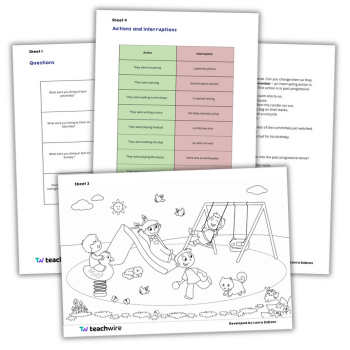Table of contents
What is past progressive tense?
Sometimes the past progressive tense is known as the past continuous tense. This is probably a better term to help remember what it is referring to.
Past progressive describes actions that were ongoing in the past and were interrupted or happened at a specific time.
Why does the past progressive tense matter?
Once you start focusing on the past progressive tense, you will notice it popping up everywhere. It is a tense we use regularly in our day-to-day lives.
It is also a huge part of other languages, such as French. By having an understanding of it at primary school, children in your class will have strong foundations for their MFL learning.
When to use past progressive tense
Use past progressive tense to describe actions that were either interrupted or ran parallel to another action. Let’s look at some examples to make this term clearer:
They were dancing in the crowd while the band was playing their favourite song.
He was watching TV when mum called him for dinner.
Interrupted actions
When an action is interrupted by another action (the boy’s television watching was interrupted by his mum calling him for dinner) the other action is often described in the simple past tense, in this case ‘called’.
Bold = past progressive
Italics = simple past tense
They were eating their picnic when the thunderstorm started.
He was playing computer games when the fire alarm started.
She was crying to her friend when her mum appeared.
Parallel actions
When two things were happening at the same time in the past, past progressive is used to describe both actions.
The girls were playing football and the boys were swimming.
Consider how the meaning changes if this was written in simple past tense:
The girls played football and the boys swam.
If someone asked, ‘What were the girls and boys doing at 2pm yesterday?’, past continuous tense would be the appropriate tense for the response.
If a child was writing a postcard to their parents from a school trip and started with, ‘Yesterday was brilliant!’ The sentence that followed would be better in simple past tense – ‘The girls played football and the boys swam.’ Deciding on simple past or past continuous depends on what you are trying to say.
Verb grid
Use the grid below to refer to if you forget the different verb tenses. Filling in one of these grids is a nice starter activity for your class, too.
| Verb | Simple past | Past progressive | Past perfect | Present progressive |
| walk | walked | was walking | had walked | am walking |
| fly | flew | was flying | had flown | am flying |
| eat | ate | was eating | had eaten | am eating |
Teaching strategies
The past progressive often stumps children when they are asked a question about it in grammar tests. However, by teaching it through some of the ideas suggested below, hopefully they will come to understand the term.
Who stole the cookie from the cookie jar?
If you have ever attended Scouts or Guides you may have played this game before. Select a child to be the investigator. Ask the rest of the class to close their eyes.
Select one pupil to ‘take a cookie from the cookie jar’. You don’t need to have a literal cookie, as long as the selected child knows that they are the ‘taker’.
Next, get all the pupils to chant, “Who took the cookie from the cookie jar?” The investigator then suggests a child and the child replies, “Who me?”. The investigator says, “Yes you” and then the child makes up a reason why they didn’t take the cookie from the cookie jar, and what they were doing instead; e.g. ”I was skydiving when the cookie was eaten.”
Keep going until the child who was selected as the ‘taker’ is found. To emphasise the past progressive, you could capture all of the reasons children give, e.g. ‘was skydiving’. Add them to a working wall.
What time is it?
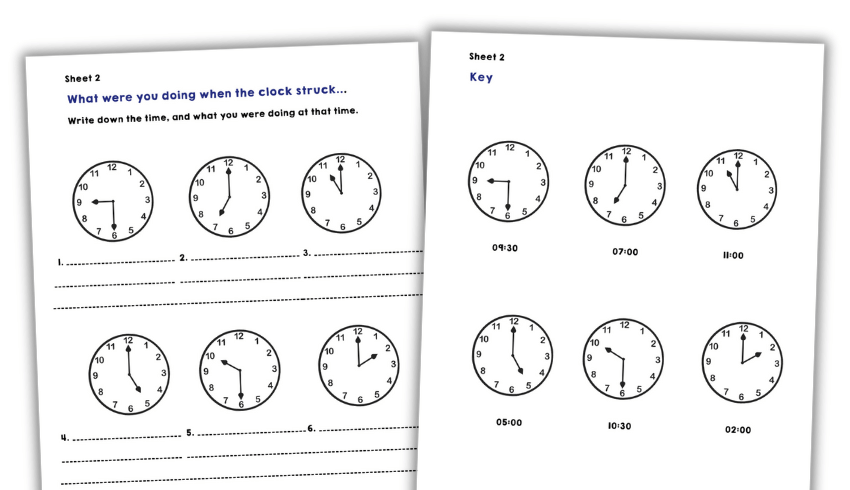
This lesson covers grammar and maths. Put cards showing various times in a box or bag. Download these activity sheets, featuring written times and analogue clocks with times, from the top of this page.
Ask children to take it in turns to pull out a time and say what they were doing at that time, using the past progressive tense. For example, if a pupil pulls out 6pm, they might say, “I was eating my dinner”.
People watching

There are various ways you can do this activity. Either use our downloadable picture , find your own picture/video or find a busy location to use.
Ask children to explain what the people are doing in the picture/place, using the past progressive tense. They may say things like, “The old men were fishing”, or “The mother was pushing her pram”. As with Who Stole the Cookie?, draw attention to the past progressive children are using in the sentences.
Let me finish!
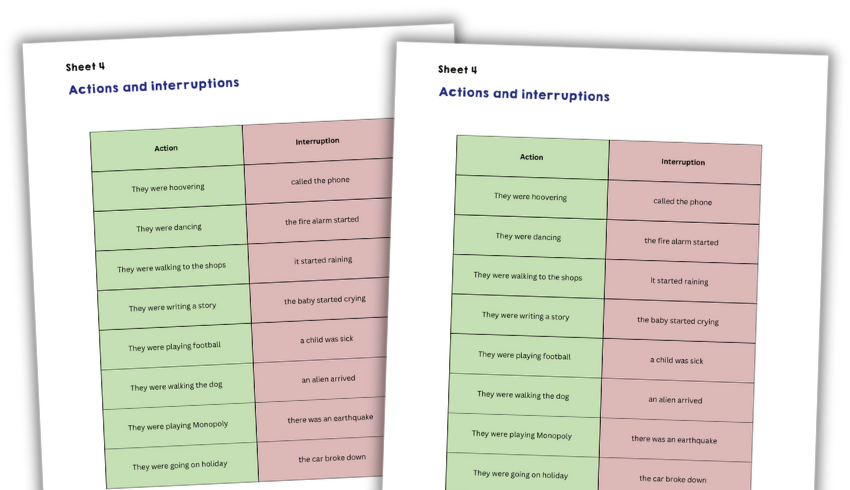
You can use our action and interruption cards for this one. First, one child acts out an action card and a second child ‘interrupts’ with their activity.
The other children watch and write on their mini whiteboards what they think was happening e.g. ‘Sam was hoovering when Thea started crying.’ Discuss which part of the sentence is the past progressive tense.
Tall tales
For this activity, organise pupils into pairs or groups. Children take turns starting a sentence with, “Yesterday, I caught you…”. They should choose something silly to finish the sentence, e.g. “Yesterday I caught you… using your lunch plate as a frisbee”.
The other children in the group then have to make up ‘tall tales’ to explain why they did that. For example, “I was throwing the lunch plate like a frisbee because I noticed it had a deeply poisonous plant on it and throwing it was the only way I could keep my classmates safe.”
As with other activities, see if children can identify the past progressive verb in the sentence.
Homework challenge
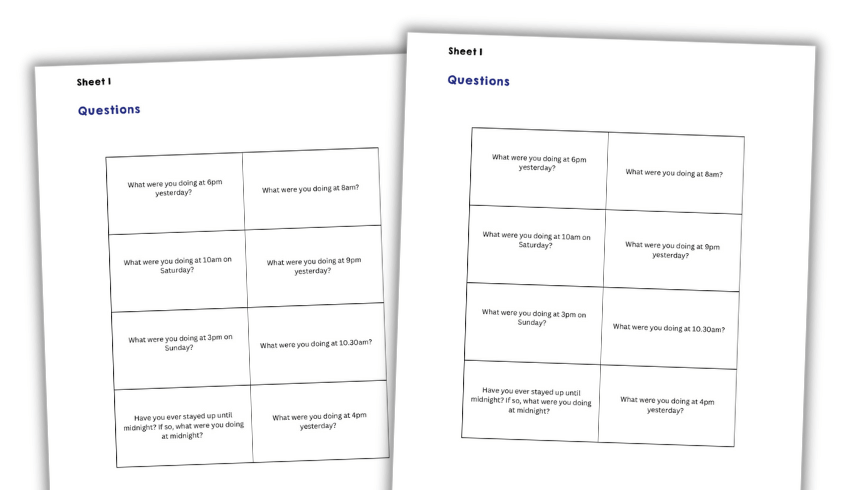
Ask children to keep a timetable of their week (again, this could link to time in mathematics). Once pupils have completed their timetables, ask them to bring them in and give the children a list of questions (use our sheet).
Ask pupils to write the answers in full sentences using the past progressive, using information from their timetables. For example, the question ‘What were you doing at 6pm yesterday?’ might have the answer, ‘At 6pm yesterday I was walking the dog with my mum’.
Traditional past progressive tense worksheet
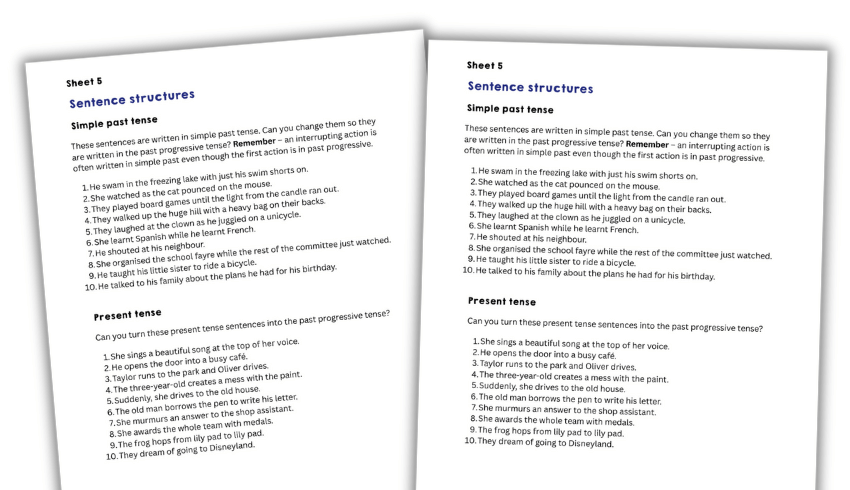
Finally, if you want to build on from the activities, get your children to have a go at our past progressive tense worksheet. Give pupils sentences in either present tense or past tense, and challenge them to change the grammar to past progressive.
After trying out these activities, your children should not only have a better understanding of what past progressive is and how to use it, they will also know how it differs from simple past tense.
Laura Dobson is deputy headteacher of a large primary school. Her key areas of expertise include English, assessment, attendance, leadership and school culture.
